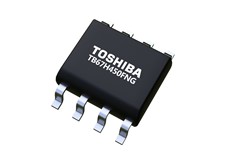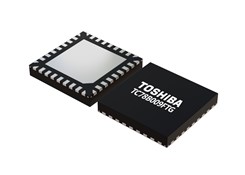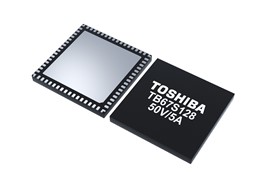Small Electric Motors are in everything we use in our daily activities. Grinding our coffee, circulating the air in our homes and offices, animating our children’s toys and maybe robotically cleaning our floors.
Depending on the motor, you will need suitable motor control drivers (MCDs) for turning the motor on and off, regulating speed and torque, and achieving high efficiency and reliability.
Depending on your design requirements and cost considerations, if it’s for a low power design, you are most likely to choose from among three types of motors
Would you like the chance to receive a free board?
Then please contact you local Arrow representative and mention our Testdrive program.
Click here for more information on Testdrive
Click on the links below to learn more about these motor technologies
Brushed DC (BDC)
Brushless DC (BLDC)
Stepping or Stepper
Brushed (BDC) motors.
Brushed DC motors are the simplest of the three types of motors and ones that we first read about in school. With windings on the rotor or armature and either permanent magnets or field windings on the stator, these motors need commutators and brushes to change the polarity of the winding during spin so that torque develops continuously in one direction. Since these motors are relatively simple to manufacture and control, they are generally cheaper and, while they are often used in toys and other cost-sensitive applications, they also find their way into home appliances, like electric blinds and locks.
Controlling BDCs is relatively simple — varying the average voltage applied to the motor varies its speed — and can be achieved with an H-bridge and a microcontroller; however, selection of driver ICs may require some thought.
That is simplified by the wide operating voltage range of the TB67H450FNG,EL from Toshiba. Its operating voltage ranges from 4.5 V all the way to 44 V for large-current (less than 3.5 A) devices, such as office automation (OA) equipment, banking terminals, home appliances, including battery-powered products like robotic vacuum cleaners, electronic locks, and small robots, and devices using 5 V USB power supplies. The driver draws just 1 μA on standby and comes in the small 8-pin HSOP8 surface-mount package.


Watch our video on the TB67H450FNG.
If you need a lower operating voltage but a larger current, the TC78H653FTG,EL is a dual-H-bridge driver IC that offers the 1.8 V-to-7.5 V operating voltage range and two current modes — the small current mode with 2.5 A DC peak in two channels and the large current mode with 5.0 A DC peak in a combined channel. Its low on resistance means more current flows through the motor for higher torque. If your project involves portable devices that use 3.6 V lithium-ion batteries, or home appliances like gas stove actuators, smart meters, electronic locks, or other applications using two 1.5 V dry batteries, this driver’s combination of characteristics make it well suited for this type of application.
If a dual channel BDC driver for up to 16 V operating voltage is needed, the new TC78H660FTG H-bridge motor driver IC, which is based on the company’s latest generation DMOS process, can deliver a PWM-controlled current of 2 A (maximum). Supporting energy efficient operation, it has ultra-low current requirements when in standby mode, drawing 0.1µA. Keeping PCB utilization to a minimum, this IC is supplied in a compact 3mm x 3mm QFN16 package. TC78H660FNG is variant of the same driver IC in a TSSOP16 package.
Toshiba offers more devices for BDC motors, with someof them pin-compatible to common brushed motor drivers so that engineers can swap parts with minimal or no change to the design in response to changing market requirements.
More Brushed DC motor driver Products
Click here for more information on Testdrive
Brushless DC (BLDC) motors
BLDC motors are mechanically simpler than the brushed ones, with typically the permanent magnets on the rotor and the windings on the stator. BLDCs eliminate the noisy, spark-prone, torque-limiting mechanical commutation, while delivering higher torque and speed. However, they require accurate control to achieve the higher efficiency they promise for applications ranging from small fans to servo mechanisms in industrial equipment.
Control over the polarity and magnitude of the current flowing through the coils and its synchronization with the rotor is achieved by measuring the position of the magnets with Hall Effect sensors or by detecting the back-electromotive force (Back-EMF) zero-crossing in sensor-less BLDCs, and feeding this information back through motor drivers. However repeated adjustments of phase differences between motor voltage and motor current are required in the rotation speed range to achieve optimal efficiency characteristics. Yet, current tends to lag in high-speed drives because of inductance at high frequencies.
A proprietary Intelligent Phase Control technology from Toshiba makes BLDC motor control simpler and more accurate. It compares the phase of the motor current and the phase of motor voltage from the Hall signal, and feeds back the result to the motor current control. The adjustment of phase difference between motor voltage and motor current is accomplished automatically over a wide range of motor speeds with merely an initial setting. This considerably reduces the development burden on the design process.
Toshiba has four new three-phase BLDC motor control solutions that use this technology, the controller parts TC78B041FNG,EL, housed in an SSOP30 package and the TC78B042FTG in a VQFN32 package, the fully integrated driver, TC78B025FTG, and the controller with integrated gate driver, TC78B027FTG. These Motor Control Devices use a sine-wave drive system for a smooth current waveform to reduce noise and vibration in high-speed motors for applications like fans, air purifiers, pumps, as well as industrial equipment.
TC78B025FTG and TC78B027FTG additionally feature a closed-loop speed control function, which regulates and maintains the rotational speed of the motor during dynamic power fluctuations and load variations. This is a valuable feature for mission-critical applications such as server fans and other cooling applications. Precise setting of a speed profile is done by the built-in non-volatile memory (NVM) and, as a result, the need for an external MCU for closed-loop speed control is eliminated.

Toshiba also offers Motor Control Devices for sensor-less operation, if your project allows sensor-less BLDCs to reduce the motor costs. The TC78B009FTG is such a three-phase pulse-width modulation (PWM) chopper driver that controls motor speed by changing the PWM duty cycle. Rated at 30 V max for power supply, it offers overlapping commutation at 120°, 135° and 142.5°, selectable soft switching, adjustable startup settings, overcurrent protection, thermal shutdown, and under-voltage lockout. Thanks to the integrated gate-driver part, the TC78B009FTG offers designers the flexibility of sizing proper power-stage MOSFETs for the applications. TC78B009FTG also contains an integrated motor current monitor to enable the MCU to make real-time adjustments. Furthermore the motor controller comprises a closed-loop speed control feature with an integrated Non-Volatile Memory (NVM), which allows operation without an external MCU.

More Brushless DC (BLDC) motor driver Products
Click here for more information on Testdrive
Stepping motors
The third type of motor you may also consider is the stepping motor. It finds use in designs that require high-precision angular motion, such as desktop printers, 3D printers, security cameras, camera lenses, medical scanners, intelligent lighting, and CNC milling machines.
Stepping motors are managed by controlling pulse width, duty cycle or period of input pulses. The challenge for stepping motor control lies in avoiding stalls, as the motors or the electronics can be burnt — if synchronization is lost during overload or a rapid speed change, the motor stalls while the driver is still conducting in full strength. This requires you to provide enough current margin to prevent sudden heavy torque changes. However, the trade-off in this setup is reduction in efficiency and increase in heat generation.
The additional current may be reduced to avoid that trade-off by implementing current adjustment through real-time monitoring of torque and current feedback with the addition of sensors and microcontrollers; however, this adds design complexity and cost.
Toshiba Active Gain Control (AGC) technology targets this problem by automatically optimizing the motor current depending on the torque needed. This prevents the motor from stalling and provides optimum control to deliver the best efficiency and lowest heat generation possible.
Find out more about AGC in the video.
Toshiba’s TB67S128FTG,EL part, a bipolar stepping motor driver offering an ultra-smooth 128 micro-steps (per quarter cycle) driving against 32 conventional steps, utilizes the AGC technology. Its 50 V / 5 A rating offers a high-power drive to applications, including 3D printers, surveillance cameras, ATMs, and office automation equipment.

Additionally, the TB67S128FTG uses Toshiba Advanced Dynamic Mixed Decay (ADMD) technology, which discharges the inductive motor current more effectively and quickly than the conventional mixed-decay mode. ADMD can stretch a generally slow speed stepper motor to its limit without missing steps. The part also takes advantage of Toshiba Advanced Current Detect System (ACDS) technology to detect current limit without external current-sensing resistors which, in turn, reduces space, part count and bill-of-materials (BOM) cost.
For application that are powered by two 1.5 V dry batteries or a single 3.6 V Li-Ion battery and hence require a lower operating voltage, the TC78H670FTG is an ideal solution. It can operate from 2.5V up to 16V and is rated up to 2A (peak). It features the Toshiba Advanced Current Detect System (ACDS) technology and a tiny 3mm x 3mm QFN package to drastically reduce board space and cost. Its package size has been reduced by 44% compared to the previous generation. The ultra-low standby current of only 0.1µA makes it a perfect choice for space restricted and battery powered applications like fiscal printers.
For more Stepper Motor Driver products.
Click here for more information on Testdrive

